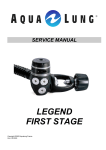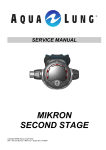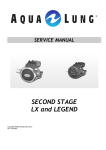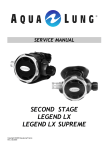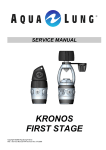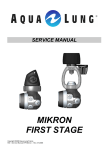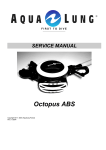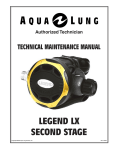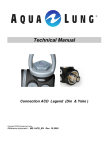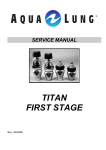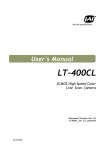Download Aqua Lung Kronos Service manual
Transcript
SERVICE MANUAL KRONOS SECOND STAGE Copyright ©2006 Aqualung France Ref : Service Manual - Kronos 2nd Stage Rev. 07/2006 2 Service Manual Kronos 2nd Stage Index COPYRIGHT............................................................................................................................... 3 INTRODUCTION........................................................................................................................ 3 WARNINGS, ATTENTION, NOTES..........................................……………............................... 3 MAINTENANCE.......................................................................................................................... 3 GENERAL INSTRUCTIONS...........................................................……..................................... 3 GENERAL CONVENTIONS............................................................…........................................ 3 DISASSEMBLY PROCEDURE..............................................................…..................................4 RE-ASSEMBLY PROCEDURE...............................................................….................................6 FINAL CHECKS.................……...............................................................…….............................9 Table 1. Troubleshooting guide................................................................…..............................10 Table 2. List of tools and service kits........................................................……….......................11 Tableau 3. Nettoyants et lubrifiants recommandés..................................................................... 12 Table 3. Recommended cleaners and lubricants.............................................….......................13 Table 4. Torque settings...........................................................................………....................... 14 Table 5. Checking specifications..............................................................……............................14 Maintenance notes ………………...........................................................…….............................15 Exploded view of Kronos Second Stage......................................................................................16 F I R S T T O 3 D I V E COPYRIGHT GENERAL INSTRUCTIONS This manual is the property of Aqualung France. Any copying, photocopying, reproduction, translation, electronic distribution (email, Internet...), even partial, and in whatever format, is expressly forbidden without the written consent of Aqualung France. 1. In order to carry out the procedures described in this manual correctly it is important that you follow the steps in the exact order indicated. Read the manual through completely so that you become familiar with all the procedures, the special tools and the replacement parts, before starting to disassemble the product. Keep this manual open near to you so that you can refer to it step by step. Do not rely on your memory. 2. All servicing and repair procedures should be carried out in a workshop that is clean, well lit, easy to access and specially fitted for the purpose. 3. The regulator body should never be directly held in the jaws of a vice. To hold the body, screw the tool 006230 into the HP port and then grip the tool with the vice. 4. Once the regulator has been disassembled, the reusable components should be separated from the components that need to be replaced. Fragile items with seats or crowns with critical sealing surfaces should be separated and protected during servicing in order to prevent any damage. 5. Use only spare parts from Aqualung service kits. Never replace an Aqualung part with one from another manufacturer, even if it appears similar. 6. Never re-use regulator parts which should be replaced on the pretext that the regulator has seen little use since its manufacture or since its last service. 7. When reassembling, check that the torque used conforms with that shown in Table 4, Torque. Some parts can be irretrievably damaged if the acceptable torque is exceeded. ©2006 Aqua Lung France. INTRODUCTION This manual gives the instructions and the recommendations for the disassembly, the cleaning, the checking, the reassembly and the adjustment of an Aqualung regulator. This manual is not an instruction manual for unqualified personnel. The procedures described in this manual are intended only for qualified personnel who have been trained in the servicing of Aqualung equipment during a specialised course. If you do not understand certain procedures in this manual you should contact an Aqualung service consultant before undertaking any operation. WARNINGS, ATTENTION, NOTES Certain icons have been used to facilitate the reading and understanding of this manual. They have the following meanings : . WARNING: Indicates situations that could result in serious or fatal accidents if the advice given is not followed correctly. . ATTENTION: Indicates a situation or action that could cause serious damage to the product, making it dangerous if the advice given is not followed correctly. GENERAL CONVENTIONS NOTE : Notes are used to emphasize important points as well as information which needs to be remembered. 1. Unscrew: to unscrew a threaded part, turn it anticlockwise. 2. Screw: to screw a threaded part, turn it clockwise. 3. Remove the O-ring: To remove an O-ring follow the method below, using the special tool provided for this purpose. Any tool that could damage the O-ring should be avoided. In every case, replace the O-ring removed with a new one. MAINTENANCE Attention: Whatever the number of dives carried out during a year, the regulator should receive a complete service each year. If the regulator is used in a chlorinated or aggressive environment the service period should be reduced to six months. In order to conform with the Aqualung Regulator Lifetime Guarantee, all servicing (inspection, servicing and repairs) should be recorded in the Service Record incorporated in the regulator User Manual. The conventions described below define the actions to be carried out when an instruction is given. Press simultaneously on the two sides of the O-ring in order to form an ‘eye’. . Insert the special tool into this eye to remove the O-ring. 4 Service Manual Kronos 2nd Stage 4. The acronyms used: LP: Low Pressure MP: Medium Pressure HP: High Pressure 5. Numbers in brackets indicate the part number of the component shown on the exploded view attached. DISASSEMBLY PROCEDURE Note: Before commencing disassembly, consult the exploded view to check the reference numbers of all parts requiring replacement. These parts should all be replaced by new parts and should not be re-used on the pretext that the regulator has seen little use since its manufacture or since its last service. 2. Attention: Use only the special tool when removing O-rings in order to avoid damaging the seal recess. The slightest scratch on a sealing surface could cause a leak. If a surface should be damaged then this part should be replaced with a new one. Do not use any pointed instrument or metal tool to remove O-rings. Using 2 11/16 spanners, hold the exchanger (127606) and unscrew the swivel nut on the hose. Remove the Oring from the hose nipple. Take care to avoid damaging the seal groove. Remove the O-ring from the hose threads. 3. Pull back the hose protectors and check that there are no dents in the crimped sleeve. The hose should not move in the metal sleeve. If it does, it should be replaced. 1. 4. Remove the clip (129154) and pull off the mouthpiece (123697). On Supreme versions, remove the lip shield (125613) 5. Unscrew the outer crown (127602). Take off the cover (Kronos : 127614 / Kronos Supreme : 127615). Using a screwdriver, lift the edge of the deflector (127622) then remove it manually by sliding it along the hose. F I R S T T O 5 D I V E 9. 6. Take out the cam manually (127609), unscrew the screw (127608) and remove the O-ring (473056) Using the tool (129001), unscrew the diaphragm nut (127625). Remove the washer (129133) and the diaphragm (127627). 7. Using the tool (129001) unscrew the plug (127624). Remove the O-ring (820016). 8. Using a screwdriver, remove the clip (127612). Slide out the venturi knob (127626). Remove the O-ring (820016) nd 10. Turn over the 2 stage and recover the shuttle-valve assembly (AP2036), spring (AP2021) and counterbalance chamber (127607). Remove the O-ring (AP2041) and the valve seat (AP2034). 11. Using a 11/16‘’ spanner, undo the screw (5). Remove the heat exchanger (127606) and remove the ’insert (127605) by turning it 1/4 turn anti-clockwise. Recover the O-ring (124706). 6 Service Manual Kronos 2nd Stage 12. Using a screwdriver (111399) unscrew the seat (AP2033). Push the tool (116236) inside the insert and push the seat out. Remove the O-ring (444243). RE-ASSEMBLY PROCEDURE 13. Left up the edge of the exhaust valve and check that the surface is clean and free from any scratches. It should be flexible and have a clean contour. If it is in good condition it is not necessary to remove it and it can be reused. If it shows any signs of deterioration it should be removed. 1. If the exhaust valve has been removed, pass the valve tail through the hole in the casing (from the outside) and pull the tail lightly into the casing. If it is a new valve, cut off any excess length leaving about 5mm. 2. Fit a new lubricated O-ring (444243) on the seat(AP2033). Screw the seat into the insert (127605) with the tool (127686). 3. Fit the insert into the casing (127617) by turning it 1/4 turn anti-clockwise. Once the insert is correctly positioned, fit a new lubricated O-ring (124706) then screw in the exchanger (127606) using a 11/16’’ spanner. END OF DISASSEMBLY Before starting to re-assemble the regulator, make sure that all replacement parts have been cleaned and lubricated in accordance with Procedure A : Cleaning and Lubricating on page 13. 4. Fit a new lubricated O-ring (AP2041) on the shuttle valve (AP2036). Fit the valve seat (AP2034). Lubricate the Oring (AP2041) correctly. F I R S T T O 7 D I V E 5. Fit the spring (AP2021) then the counter-balance chamber (127607). Hold the casing vertical with the lever perpendicular to the insert. Fit the assembly into the insert taking care to position the tabs of the shuttle valve facing the tabs on the lever. A gap of between 1 and 2.5 mm in maxi position 9. 6. Fit the cam (127609) by screwing it manually anticlockwise (to the left). 7. Fit a new lubricated O-ring (121130) on the venturi knob (127626). Take care to avoid putting the O-ring in the groove intended for the clip (127612) but in the straighter groove. Press on the lever and check that it returns to the high position (the sign that the shuttle valve is well positioned). Fit the clip (127612) onto the knob (127626). 10. Fit a new lubricated O-ring (473056) onto the adjusting screw (127608). Using a screwdriver (size 2.5mm) screw in the screw until the O-ring is no longer visible (top of the spring flush with the groove). 8. Fit the venturi knob (127626) onto the tool (127686). Place the slot in the tool in the groove in the cam (127609). Turn the tool anti-clockwise until the cam comes into contact with the insert (127605). Come back 1/4 turn (clockwise) and fit the knob in the maxi position matching the octagonal flats on the cam and the knob. In the maxi position the octagonal part of the cam should be under the upper face by about 1mm to 2.5mm. 11. Fit a new lubricated O-ring on the hose threads. Fit a new lubricated O-ring on the hose nipple. 8 Service Manual Kronos 2nd Stage 12. Ajustement du Levier (129178). Attach the adjusting connector (122041) on the adjustment tool (122046). Connect a MP hose to the tool and then fit the assembly to a Kronos 1st stage that has its MP set to 9.5 bar. Put the regulator under pressure. Slide the tool (127686) across the top of the casing. With the tool in maxi position the 2nd stage should leak when the tool presses on the lever. With the nd tool in the mini position, the 2 stage should not leak. Screw the seat in or out to adjust the setting. Hole aligned with the insert axis After tightening the diaphragm nut, hold the top of the diaphragm and pull lightly in all directions to check that it is securely held in the casing. Check that it is not jammed. If this is the case, reinstall it. 15. Position the push button (127614) so that the markings are aligned. Engage the internal lugs of the button in the holes in the nut (127625). Using a lug spanner (129198) screw down the crown (127602). 13. Unscrew the screw (127608) until the second stage leaks then screw it 1 Turn 1/2. Fit a new lubricated Oring (820016) onto the plug (127613) Screw the plug completly then unscrew it 1/8 turn. 14. Close the air supply and purge the 2nd stage. Remove the adjustment tool. Fit the diaphragm (127627). Press well in all around its edges to ensure that it is correctly positioned. Fit the washer (129133) the using tool (129001) screw in the diaphragm nut (127625). Adjust the tightening so that one of the holes is aligned with the insert axis. 16. Fit the deflector (127622) on to the hose and then connect the hose to the 2nd stage. Using 2 11/16 ‘’ spanners, tighten the hose nut while holding the exchanger (127606). 17. Refit the deflector on the casing. The deflector should pass under the lug under the mouthpiece. Once the deflector has been passed under the lug, fit the deflector over the “return” of the casing by pushing on the centre of the spherical part. To lock the assembly, press on the tongue to make the little rod on the casing enter the tongue. Finally, check that the deflector is correctly positioned. F I R S T T O 9 D I V E FINAL CHECKS 1. Pressurise the regulator to 200 bar (±10 bar) Note: Tests 2,3 et 4 require the use of a regulator test bench. Correct position of the deflector 2. Check opening effort. Apply a gradual inhalation effort. When the MP starts to fall, release the pressure and compare the result with the limits shown in Table 5. Checking Specifications . If the opening effort is outside these limits consult Table 1. Troubleshooting Guide. 3. Check depression / flow. Apply an inhalation flow of 400 l/min and check that the depression oes not exceed 15 mbar. If it exceeds this value consult Table 1. Troubleshooting Guide. Note : if you have a test bench, carry out these test before fitting the mouthpiece. Test instructions are given in the section Final Checks. 18. Fit the mouthpiecel (123697) on to the casing. If it is a Comfobite mouthpiece check that the support is at the top. Fit the mouthpiece collar (129154) into the groove provided. The collar lever should be underneath and positioned on the hose side. 4. Check for leaks. Connect the first stage to a cylinder charged to 200 bar, open the valve and submerge the assembly in a bath of water for 1 minute. Check that there are no leaks. If there are apparent leaks, nd disassemble the 2 stage completely and check all sealing surfaces and the positioning of the parts. END OF REASSEMBLY 19. If the regulator is a Kronos Supreme, fit the lip shield (36) over the mouthpiece and against the mouthpiece collar. 10 Service Manual Kronos 2nd Stage Table 1. Troubleshooting Guide SYMPTOM Leak or free flow at 2nd stage Insufficient purge flow or work of breathing too high Water leak POSSIBLE CAUSE TREATMENT 1. MP too high 1. Refer to First stage Troubleshooting Guide 2. The valve (AP2034) is worn or damaged. 2. Replace the valve 3. The seat (AP2033) is not correctly adjusted 3. Readjust the seat 4. The lever (129178) is bent 4. Replace the lever 5. The sealing face of the seat (AP2033) is damaged. 5. Replace the seat 6. The spring (2021) is damaged 6. Replace the spring 1. MP too low 1. Refer to First stage Troubleshooting Guide 2. The valve (AP2033) is not correctly adjusted, the lever adjustment is too low 2. Readjust the lever and the valve 3. MP hose obstructed 3. Clean or replace the hose 4. The lever (129178) is bent 4. Replace the lever 1. Hole in mouthpiece (123697) 1. Replace the mouthpiece 2. Diaphragm (129150) damaged 2. Replace the diaphragm 3. Exhalation valve (129174) damaged 3. Replace the valve 4. The venturi control O-ring (121130) is dirty, worn or damaged 4. Replace the O-ring 5. 5. The diaphragm is not correctly fitted between the casing (127617) and the washer (127625) 5. Disassemble the purge button and refit the assembly correctly 6. The casing is damaged. 6. Check the sealing face of the exhalation valve. Replace the casing 7. The O-ring (820016) is damaged. 7. Replace the O-ring 8. The insert O-ring (124706) is damaged. 8. Replace the O-ring Service Manual Kronos 2nd Stage 11 Table 2. List of Tools and Service Kits DESCRIPTION APPLICATION US PART NO. MP pressure gauge complete 0/16B Checking medium pressure 111610 O-ring tool Fitting and removing O-rings 944022 129001 Spring clip tool Fitting and removing diaphragm clip (15) 129001 116236 Seat fitting tool Seat assembly/disassembly 109436 127686 Seat / lever adjusting tool Seat assembly / lever adjusting N/a 129198 Ring tool for Kronos Tighten/loosen gold/silver ring on Legend LX N/a 122046 + 122041 Seat adjustment tool Adjusting seat under pressure Torque wrench 0.5 m.kg Plugs N/a N/C Medium flat wrench seat N/a N/C Flat wrench 17mm (x2) Hose nut N/a N/C 4mm Allen key MP et HP plugs N/a REF 116222 N/C 122155 127682 Service Kit Kronos 2 nd stage Kronos 2nd stage, Kronos Supreme 2nd stage 100190 12 Service Manual Kronos 2nd Stage Table 3. Recommended cleaners and lubricants LUBRICANT / CLEANER Christolube MCG 111 APPLICATION All O-rings SOURCE Aqualung, ref. 480025 Attention: Silicone parts do not require lubrication. Do not grease them. Greasing silicone parts can change their molecular construction and cause premature degradation of the material. Oakite #31 Acid bath for cleaning brass and stainless steel parts. Oakite Products, Inc. NETALU Acid bath for cleaning brass and stainless steel parts. Aqualung, ref. 455001 Diluted white vinegar Acid bath for cleaning brass and stainless steel parts. Household stores Attention: Do not use hydrochloric acid for cleaning parts. Hydrochloric acid, even when well diluted, attacks the coating of metal parts and leaves a corrosive deposit that damages plastic parts and O-rings. Washing-up liquid (diluted with hot water) Degreases brass and stainless steel parts; Household stores general cleaning of plastic and rubber parts. Disinfectant STERANIOS 2% Disinfectant for all plastic and metal parts. Aqualung ref : 382062 Service Manual Kronos 2nd Stage 13 Procedure A Cleaning and Lubricating (All Aqualung Regulators) Cleaning brass and stainless steel parts. 1. 2. 3. Pre-clean by soaking in NETALU diluted to 25%. Cleaning in an ultra-sonic bath filled with a mixture of washing-up liquid + hot water. If some resistant deposits remain then fill the ultrasonic bath with white vinegar and repeat. DO NOT put plastic, rubber, silicone or anodised aluminium parts in contact with vinegar. Rinse in demineralised or fresh water to avoid calcium deposits. Soak for 10 minutes. Dry with filtered low pressure air and then check that their condition is now suitable for re-use. Cleaning plastic, rubber and anodised aluminium parts. For anodised aluminium parts : soak in a « NETALU diluted to 25% ». Rinse in fresh water and dry with low-pressure filtered air. For plastic parts. (casings, plugs..) : clean in an ultrasonic bath containing a mixture of washing-up liquid and hot water. Use only a toothbrush with nylon bristles to remove any deposits. Rinse in fresh water and dry with low-pressure filtered air Attention: D not place plastic and rubber parts in contact with acid solutions. This could alter their physical properties and cause degradation and premature breakdown. Disinfecting parts . For disinfection, leave plastic and metal parts to soak for 20 minutes in a bath of STERANIOS 2% ref. 382062 (ready to use). Rinse the parts thoroughly after soaking. Toxic product, follow the instruction for its use. Cleaning parts for Nitrox/O2 use. 1. 2. 3. 4. Metal parts : Pre-clean by soaking in NETALU diluted to 25%. Ultrasonic cleaning in Promoclean TP108 diluted at 5% . Rinse in demineralised water. Soak for 10 min. Dry in the open air in a clean and dust-free atmosphere. Place the parts on a white cloth, allow to dry and check after drying that the cloth shows no grease deposits and that the condition of the parts is appropriate for re-use with Nitrox/O2. Cleaning hoses. If there is significant corrosion then it is permissible to soak only the ends in an ultrasonic bath, avoiding any possibility of the solution entering the hose. Rinse in fresh water and allow to dry with the connections hanging down. Dry the inside with filtered compressed air before reconnecting the hose to the regulator. Wiping. To wipe parts, use a white filter paper, a pure cotton cloth or any other material that does not produce fluff. Inspection. Visually check under a white light (day light or artificial light). The parts are completely free of any traces of : 1. 2. 3. 4. organic materials (oil, grease, paint, rust…) cleaning agents dust humidity Lubrication. When handling O-rings wear unpowdered latex gloves. It is important not to allow contact between the internal components and the skin or any other source of contamination when the regulator is being prepared for Nitrox use. All seals should be lubricated with Christolube MCG111. Cover the seals with a light film of grease and remove any excess by rolling the seal between finger and thumb. Do not use an excess of grease; this can have the effect of accumulating particles that could damage the O-rings. 14 Service Manual Kronos 2nd Stage Table 4. Torque values N° REFERENCE DESCRIPTION FORCE 127606 Hear exchanger 0.5 m.kg. Table 5. Checking specifications TEST INSTRUCTIONS SPECIFICATIONS Leak Test 160 bar < Working pressure < 200 bar No leak Medium Pressure 160 bar < Working pressure < 200 bar MP at 9.5 bar ± 0.5 bar : KRONOS (all versions) Opening effort 160 bar < Working pressure < 200 bar Kronos (all versions) : between 2.8 mbar and 3.8 mbar Effort / Flow MP at 9.5 bar ± 0.5 bar : Kronos (all versions) 15 mbar maxi at 400 L/min 15 Service Manual Kronos 2nd Stage Maintenance Notes. 16 Service Manual Kronos 2nd Stage Exploded view of Kronos 2nd stage. 17 Service Manual Kronos 2nd Stage Exploded view of Kronos Supreme 2nd Stage 18 Service Manual Kronos 2nd Stage Exploded view of Kronos Octopus 2nd Stage 19 Service Manual Kronos 2nd Stage 1ere Avenue – 14e rue – BP 148 06513 CARROS cedex – France 00.33.(0)4.92.08.28.88 FAX 00.33.(0)4.92.08.28.99



















